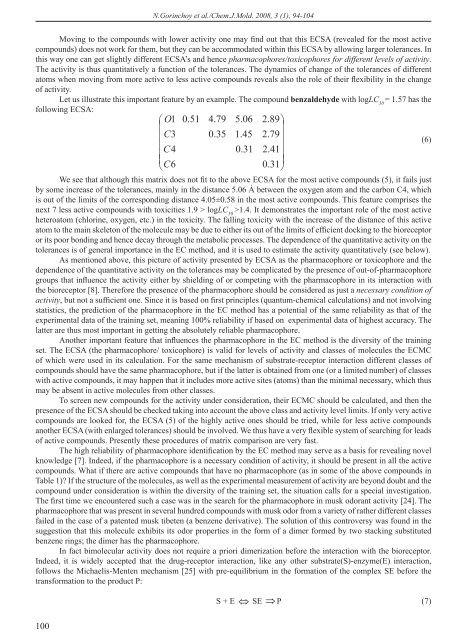chemistry journal of moldova
chemistry journal of moldova
chemistry journal of moldova
Create successful ePaper yourself
Turn your PDF publications into a flip-book with our unique Google optimized e-Paper software.
N.Gorinchoy et al./Chem.J.Mold. 2008, 3 (1), 94-104Moving to the compounds with lower activity one may find out that this ECSA (revealed for the most activecompounds) does not work for them, but they can be accommodated within this ECSA by allowing larger tolerances. Inthis way one can get slightly different ECSA’s and hence pharmacophores/toxicophores for different levels <strong>of</strong> activity.The activity is thus quantitatively a function <strong>of</strong> the tolerances. The dynamics <strong>of</strong> change <strong>of</strong> the tolerances <strong>of</strong> differentatoms when moving from more active to less active compounds reveals also the role <strong>of</strong> their flexibility in the change<strong>of</strong> activity.Let us illustrate this important feature by an example. The compound benzaldehyde with logLC 50= 1.57 has thefollowing ECSA: O10.51 4.79 5.06 2.89C30.35 1.45 2.79(6)C40.31 2.41C60.31We see that although this matrix does not fit to the above ECSA for the most active compounds (5), it fails justby some increase <strong>of</strong> the tolerances, mainly in the distance 5.06 between the oxygen atom and the carbon C4, whichis out <strong>of</strong> the limits <strong>of</strong> the corresponding distance 4.05±0.58 in the most active compounds. This feature comprises thenext 7 less active compounds with toxicities 1.9 > logLC 50>1.4. It demonstrates the important role <strong>of</strong> the most activeheteroatom (chlorine, oxygen, etc.) in the toxicity. The falling toxicity with the increase <strong>of</strong> the distance <strong>of</strong> this activeatom to the main skeleton <strong>of</strong> the molecule may be due to either its out <strong>of</strong> the limits <strong>of</strong> efficient docking to the bioreceptoror its poor bonding and hence decay through the metabolic processes. The dependence <strong>of</strong> the quantitative activity on thetolerances is <strong>of</strong> general importance in the EC method, and it is used to estimate the activity quantitatively (see below).As mentioned above, this picture <strong>of</strong> activity presented by ECSA as the pharmacophore or toxicophore and thedependence <strong>of</strong> the quantitative activity on the tolerances may be complicated by the presence <strong>of</strong> out-<strong>of</strong>-pharmacophoregroups that influence the activity either by shielding <strong>of</strong> or competing with the pharmacophore in its interaction withthe bioreceptor [8]. Therefore the presence <strong>of</strong> the pharmacophore should be considered as just a necessary condition <strong>of</strong>activity, but not a sufficient one. Since it is based on first principles (quantum-chemical calculations) and not involvingstatistics, the prediction <strong>of</strong> the pharmacophore in the EC method has a potential <strong>of</strong> the same reliability as that <strong>of</strong> theexperimental data <strong>of</strong> the training set, meaning 100% reliability if based on experimental data <strong>of</strong> highest accuracy. Thelatter are thus most important in getting the absolutely reliable pharmacophore.Another important feature that influences the pharmacophore in the EC method is the diversity <strong>of</strong> the trainingset. The ECSA (the pharmacophore/ toxicophore) is valid for levels <strong>of</strong> activity and classes <strong>of</strong> molecules the ECMC<strong>of</strong> which were used in its calculation. For the same mechanism <strong>of</strong> substrate-receptor interaction different classes <strong>of</strong>compounds should have the same pharmacophore, but if the latter is obtained from one (or a limited number) <strong>of</strong> classeswith active compounds, it may happen that it includes more active sites (atoms) than the minimal necessary, which thusmay be absent in active molecules from other classes.To screen new compounds for the activity under consideration, their ECMC should be calculated, and then thepresence <strong>of</strong> the ECSA should be checked taking into account the above class and activity level limits. If only very activecompounds are looked for, the ECSA (5) <strong>of</strong> the highly active ones should be tried, while for less active compoundsanother ECSA (with enlarged tolerances) should be involved. We thus have a very flexible system <strong>of</strong> searching for leads<strong>of</strong> active compounds. Presently these procedures <strong>of</strong> matrix comparison are very fast.The high reliability <strong>of</strong> pharmacophore identification by the EC method may serve as a basis for revealing novelknowledge [7]. Indeed, if the pharmacophore is a necessary condition <strong>of</strong> activity, it should be present in all the activecompounds. What if there are active compounds that have no pharmacophore (as in some <strong>of</strong> the above compounds inTable 1)? If the structure <strong>of</strong> the molecules, as well as the experimental measurement <strong>of</strong> activity are beyond doubt and thecompound under consideration is within the diversity <strong>of</strong> the training set, the situation calls for a special investigation.The first time we encountered such a case was in the search for the pharmacophore in musk odorant activity [24]. Thepharmacophore that was present in several hundred compounds with musk odor from a variety <strong>of</strong> rather different classesfailed in the case <strong>of</strong> a patented musk tibeten (a benzene derivative). The solution <strong>of</strong> this controversy was found in thesuggestion that this molecule exhibits its odor properties in the form <strong>of</strong> a dimer formed by two stacking substitutedbenzene rings; the dimer has the pharmacophore.In fact bimolecular activity does not require a priori dimerization before the interaction with the bioreceptor.Indeed, it is widely accepted that the drug-receptor interaction, like any other substrate(S)-enzyme(E) interaction,follows the Michaelis-Menten mechanism [25] with pre-equilibrium in the formation <strong>of</strong> the complex SE before thetransformation to the product P:S + E SE P (7)100
















